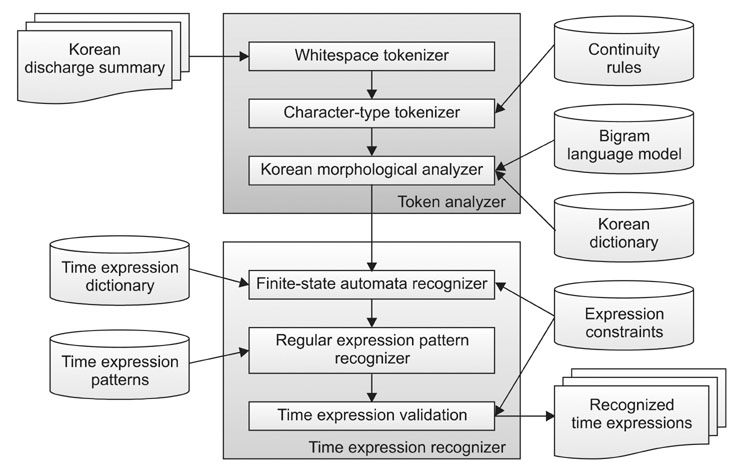Healthc Inform Res.
2011 Sep;17(3):150-155. 10.4258/hir.2011.17.3.150.
Recognizing Temporal Information in Korean Clinical Narratives through Text Normalization
- Affiliations
-
- 1Interdesciplinary Program of Bioengineering, College of Engineering, Seoul National University, Seoul, Korea.
- 2Department of Biomedical Engineering, College of Medicine, Seoul National University, Seoul, Korea. jinchoi@snu.ac.kr
- KMID: 1974240
- DOI: http://doi.org/10.4258/hir.2011.17.3.150
Abstract
OBJECTIVES
Acquiring temporal information is important because knowledge in clinical narratives is time-sensitive. In this paper, we describe an approach that can be used to extract the temporal information found in Korean clinical narrative texts.
METHODS
We developed a two-stage system, which employs an exhaustive text analysis phase and a temporal expression recognition phase. Since our target document may include tokens that are made up of both Korean and English text joined together, the minimal semantic units are analyzed and then separated from the concatenated phrases and linguistic derivations within a token using a corpus-based approach to decompose complex tokens. A finite state machine is then used on the minimal semantic units in order to find phrases that possess time-related information.
RESULTS
In the experiment, the temporal expressions within Korean clinical narratives were extracted using our system. The system performance was evaluated through the use of 100 discharge summaries from Seoul National University Hospital containing a total of 805 temporal expressions. Our system scored a phrase-level precision and recall of 0.895 and 0.919, respectively.
CONCLUSIONS
Finding information in Korean clinical narrative is challenging task, since the text is written in both Korean and English and frequently omits syntactic elements and word spacing, which makes it extremely noisy. This study presents an effective method that can be used to aquire the temporal information found in Korean clinical documents.
Keyword
MeSH Terms
Figure
Cited by 1 articles
-
Temporal Segmentation for Capturing Snapshots of Patient Histories in Korean Clinical Narrative
Wangjin Lee, Jinwook Choi
Healthc Inform Res. 2018;24(3):179-186. doi: 10.4258/hir.2018.24.3.179.
Reference
-
1. Deshpande AM, Brandt C, Nadkarni PM. Temporal query of attribute-value patient data: utilizing the constraints of clinical studies. Int J Med Inform. 2003. 70:59–77.
Article2. Shahar Y, Combi C. Timing is everything. Time-oriented clinical information systems. West J Med. 1998. 168:105–113.3. Bui AA, Taira RK, El-Saden S, Dordoni A, Aberle DR. Automated medical problem list generation: towards a patient timeline. Stud Health Technol Inform. 2004. 107(Pt 1):587–591.4. Allen RB. A focus-context browser for multiple timelines. Proceedings of the 5th ACM/IEEE-CS Joint Conference on Digital Libraries. 2005 Jun 7-11; Denver, CO. 260–261.
Article5. Aliferis CF, Cooper GF, Pollack ME, Buchanan BG, Wagner MM. Representing and developing temporally abstracted knowledge as a means towards facilitating time modeling in medical decision-support systems. Comput Biol Med. 1997. 27:411–434.
Article6. Verhagen M, Mani I, Sauri R, Littman J, Knippen R, Jang SB, Rumshisky A, Phillips J, Pustejovsky J. Automating temporal annotation with TARSQI. 2005. Stroudsburg, PA: Association for Computational Linguistics.7. Ahn D, Adafre SF, de Rijke M. Extracting temporal information from open domain text: a comparative exploration. J Digit Inf Manag. 2005. 3:14–20.8. Zhou L, Parsons S, Hripcsak G. The evaluation of a temporal reasoning system in processing clinical discharge summaries. J Am Med Inform Assoc. 2008. 15:99–106.
Article9. Kim H. Korean national corpus in the 21st century Sejong project [Internet]. cited at 2011 Aug 16. Available from: http://tokuteicorpus.jp/result/pdf/2006_006.pdf.10. Stolcke A. SRILM-an extensible language modeling toolkit. Proceedings of 7th International Conference on Spoken Language Processing (ICSLP). 2002 Sep 16-20; Denver, CO. 901–904.11. Uzuner O, Solti I, Cadag E. Extracting medication information from clinical text. J Am Med Inform Assoc. 2010. 17:514–518.
Article12. Hacioglu K, Chen Y, Douglas B. Automatic time expression labeling for English and Chinese text. CICLing 2005: Sixth International Conference on Intelligent Text Processing and Computational Linguistics. 2005 Feb 13-19; Mexico City. 548–559.
Article13. Jang SB, Baldwin J, Mani I. Automatic TIMEX2 tagging of Korean news. ACM Trans Asian Lang Inf Process. 2004. 3:51–65.
Article
- Full Text Links
- Actions
-
Cited
- CITED
-
- Close
- Share
- Similar articles
-
- How to Deal with Medical Narratives based on Controlled Natural Language Operated by an Ontology
- Improving the CONTES method for normalizing biomedical text entities with concepts from an ontology with (almost) no training data
- Visualization of unstructured personal narratives of perterm birth using text network analysis
- An Implementation of Natural Language Processing and Text Mining in Stroke Research
- The Acceptable Text Similarity Level in Manuscripts Submitted to Scientific Journals




